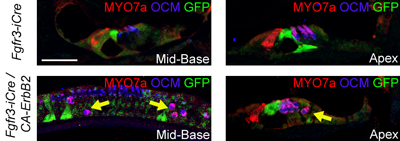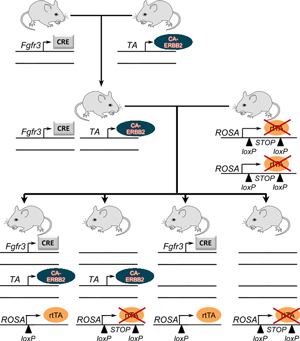Molecular Mechanisms in Cochlear Regeneration

Cross-section of a young mouse cochlea, with hair
cells in pink and supporting cells in green
Why don’t mammals regenerate dying auditory cells? What signals can stimulate cochlear supporting cell proliferation, and what signals stimulate hair cell differentiation? More importantly, if it is possible to stimulate these actions in cochlear cells, why don’t they occur after mammals are deafened? Are the signals not present, or are they blocked somehow?

Ectopic Hair Cell
This is what we know: mammalian supporting cells retain some plasticity to turn on hair cell-specific genes throughout development. Purified supporting cells become hair cells under certain cell culture conditions; there are drugs that induce immature supporting cells to convert to hair cells in organ culture; and forced expression of hair cell specific transcription factors in supporting cells can induce at least part of the hair cell differentiation program. Inducing cell division in supporting cells is a trickier problem. Supporting cells express tumor suppressor proteins, and they can re-enter the cell cycle, at least sporadically, if these proteins are mutated. As supporting cells mature, their ability to re-enter the cell cycle is severely reduced, compared to younger cells in the same assay.
We are testing a candidate signaling pathway, ERBB2, for its abilities to drive hair cell differentiation, supporting cell proliferation, and hearing restoration after damage. We employ both genetic expression systems and small molecule activation strategies. We recently discovered that the activation of ERBB2 signaling in neonatal mouse supporting cells appeared to initiate a cascade of signaling that induced the differentiation of ectopic hair cells. Experiments are in progress to determine what the effects are of activating ERBB2 signaling after hair cell damage in young and adult mice.

Our Breeding Strategy